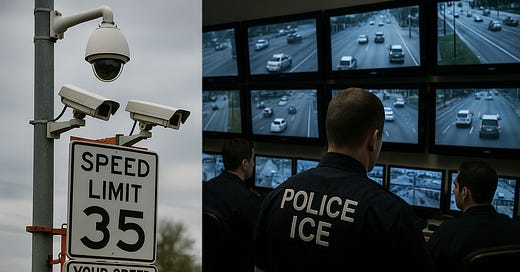In a country where the right to privacy was once a constitutional cornerstone, a quiet revolution is reshaping how law enforcement finds, tracks, and detains people. And it’s being done not through search warrants or neighborhood patrols—but by AI-powered surveillance towers, facial recognition cameras hidden in speed signs, and covert license plate tracking systems with predictive behavior models.
This isn’t dystopian fiction. It’s real, it’s operational, and it’s happening right now—in plain sight
.
🚨 The Hidden Infrastructure of the Trump-Era ICE Revival
Donald Trump’s renewed immigration campaign isn’t powered solely by rhetoric or raids—it’s powered by a vast, high-tech surveillance network initially designed for military and border security use but now being deployed across cities, highways, and neighborhoods. The tools used to target immigrants and activists alike are built by powerful private contractors like Palantir, Anduril, Leonardo, Elbit Systems, and Flock Safety—all feeding data into interconnected law enforcement databases.
The Department of Homeland Security (DHS), U.S. Customs and Border Protection (CBP), Immigration and Customs Enforcement (ICE), and even your local police department now use AI systems that can:
Identify your car and its travel patterns—even without a readable license plate
Recognize your face in a crowd using hidden cameras
Flag your “suspicious behavior” using pattern-recognition algorithms
Secretly track your vehicle with hidden GPS devices
Build dossiers by fusing your movements, associations, and digital footprint
These technologies don’t just observe you—they decide if you’re a threat, sometimes before you’ve done anything wrong.
🔍 How It Works: The AI Surveillance Stack
The U.S. border surveillance ecosystem is built on three key technological pillars:
Automated License Plate Recognition (ALPR):
Companies like Flock Safety, Rekor, and Leonardo/ELSAG install cameras on streetlights, patrol cars, and even in traffic barrels to record and track your vehicle across cities. ICE, CBP, and local police all have access to vast ALPR databases—some with over 6 billion license plate reads.Facial Recognition & Covert Cameras:
Events like music festivals, protests, or airport arrivals are now hotbeds for real-time facial scanning. Agencies use systems from Clearview AI, Trust Stamp, and others to match faces against watchlists. These feeds come from fixed cameras, drones, and hidden units in street infrastructure such as those temporary roadside speed limit signs that flash your current speed.Behavioral Anomaly Detection & AI Prediction:
Tools from Pangiam, BigBear.ai, and Anduril analyze vehicle movement patterns and crowd behavior to predict who might be a trafficker, protest organizer, or undocumented migrant—even without prior criminal history. This is predictive policing, and it’s already being used to justify surveillance and detentions.
💥 From Border Security to Local Surveillance
What started as border technology is now infiltrating municipal law enforcement. Through systems like Palantir’s Gotham and Anduril’s Lattice OS, data is shared seamlessly between federal agencies and local police—turning small-town cops into real-time intelligence analysts.
Over 80 local agencies currently share license plate data with ICE via Vigilant Solutions
Palantir’s case management system (ICM) builds "target profiles" on anyone flagged—even citizens
Real-Time Crime Centers in cities nationwide now link ALPR, facial recognition, and AI alerts into centralized dashboards
The federalization of surveillance tools means your local traffic camera may be contributing to a federal deportation operation—or targeting political activists.
⚖️ The Legal Black Hole and the 4th Amendment Crisis
In United States v. Jones (2012), the Supreme Court ruled that placing a GPS tracker on a car constitutes a search under the 4th Amendment and typically requires a warrant. But today’s AI systems flag targets before a warrant is issued, using algorithmic suspicion instead of probable cause.
Many covert actions—like attaching hidden GPS devices—are now done based on AI-generated alerts alone, often with no judicial oversight. The law hasn't caught up, and ICE uses loopholes by buying private data instead of subpoenaing it.
🧠 The Human Cost: False Positives, Bias, and Misuse
Despite claims of 90% success rates, these systems:
Have higher misidentification rates for minorities, women, and non-binary individuals
Flag innocent people due to algorithmic bias
Are used to justify abductions, deportations, or harassment—even of U.S. citizens
A false match could lead to detainment, interrogation, or worse. Meanwhile, most Americans have no way to challenge or even view the surveillance data being used against them.
🛑 What You Can Do: Awareness, Resistance, and Reform
This isn’t just about immigration. It’s about power, automation, and the quiet normalization of authoritarian tools.
You can:
Support groups like EFF, ACLU, and No Tech For Tyrants
Demand transparency from your local police or city council on LPR and surveillance tech contracts
Push for legislation requiring warrants for AI-flagged surveillance
Educate others before this becomes the permanent status quo
🧭 Final Thoughts
The tools that once tracked terrorists overseas now follow you to the grocery store. And the greatest threat isn’t just that they’re being used—it’s that you’re not supposed to know.
In this series, I’ll continue exposing the vendors, laws, and power structures behind these digital dragnet systems. Because sunlight is the only antidote to secret policing.
“We are rapidly building the architecture of oppression—under the illusion of safety.”




